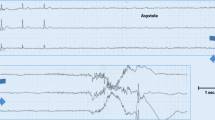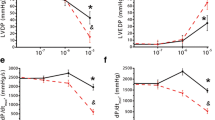Summary
Experiments were carried out in anaesthetized, thoracotomized dogs. The dose dependent positive inotropic and chronotropic effects of intracoronary (i.cor.) infusions or bolus injections of isoproterenol (ISO) were neither antagonized by adenosine (0.46, 1.0, and 2.91×10−5 mol/l) nor by the adenosine analogue N6-phenylisopropyl-adenosine (PIA, 3.23×10−7 mol/l). The results indicated, that adenosine and PIA do not have any antagonistic effects on isoproterenol induced positive inotropy and chronotropy in the intact dog heart. Consequently it can be assumed that an adenosinecatecholamine antagonism is of no physiological relevance.
Similar content being viewed by others
References
Baumann G, Schrader J, Gerlach E (1981) Inhibitory action of adenosine on histamine-and dopamine-stimulated cardiac contractility and adenylate cyclase in guinea pigs. Circ Res 48:259–266
Belardinelli L, Mattos EC, Berne RM (1981) Evidence for adenosine mediation of atrioventricular block in the ischemic canine myocardium. J Clin Invest 68:195–205
Berne R (1964) Regulation of coronary blood flow. Physiol Rev 44:1–29
Berne RM (1963) Cardiac nucleotides in hypoxia: Possible role in regulation of coronary blood flow. Am J Physiol 204:317–322
Chiba S, Himori H (1975) Different inotropic responses to adenosine on the atrial and ventricular muscle of the dog heart. Jpn J Pharmacol 25:489–491
Ceremuzynski L (1981) Hormonal and metabolic reactions evoked by acute myocardial infarction. Circ Res 48:767–776
Dobson JG (1983) Mechanism of adenosine inhibition of catecholamine-induced responses in heart. Circ Res 52:151–160
Endoh M, Yamashita S (1980) Adenosine antagonizes the positive inotropic action mediated via β-, but not α-adrenoceptors in the rabbit papillary muscle. Eur J Pharmacol 65:445–448
Fox AC, Reed GE, Glassman E, Kaltman AJ, Silk BB (1974) Release of adenosine from human hearts during angina induced by rapid atrial pacing. J Clin Invest 53:1447–1457
Gazes PC, Richardson JA, Woods EF (1959) Plasma catecholamine concentrations in myocardial infarction and angina pectoris. Circulation 19:657–661
Gerlach E, Deutike B, Dreissbach RH (1963) Der Nucleotid —Abbau im Herzmuskel bei Sauerstoffmangel und seine mögliche Bedeutung für die Coronardurchblutung. Naturwissenschaften 50:228–229
Hedqvist P, Fredholm BB (1979) Inhibitory effect of adenosine on adrenergic neuroeffector transmission in the rabbit heart. Acta Physiol Scand 105:120–122
Imai S, Riley AL, Berne RM (1964) Effect of ischemia on adenine nucleotides in cardiac and skeletal muscle. Circ Res 15:443–450
Lokhandwala MF (1979) Inhibition of cardiac sympathetic neurotransmission by adenosine. Eur J Pharmacol 60:353–357
Lukomsky PE, Oganov RG (1972) Blood plasma catecholamines and their urinary excretion in patients with acute myocardial infarction. Am Heart J 83:182–188
McDonald L, Baker C, Bray C, McDonald A, Restieaux N (1969) Plasma-catecholamines after cardiac infarction. Lancet 2: 1021–1023
Raab W (1963) The nonvascular metabolic myocardial vulnerability factor in “coronary heart disease”. Am Heart J 66:685–706
Rubio R, Berne R (1969) Release of adenosine by the normal myocardium in dogs and its relationship to the regulation of coronary resistance. Circ Res 25:407–415
Schmitz W, Hackbarth I, Haubitz B, Linhart R, Meyer W, Scholz H (1981) Effect of adenosine and isoprenaline on force of contraction and on the c-AMP system in guinea-pig atria. Naunyn-Schmiedeberg's Arch Pharmacol 316:R34
Schmitz W, Böhm M, Hackbarth I, Schmidt B (1982) Effects of adenosine on force of contraction and the cAMP and cGMP content in guinea pig hearts in the presence of isoprenaline. Naunyn-Schmiedeberg's Arch Pharmacol 319:R38
Schrader J, Haddy FJ, Gerlach E (1977a) Release of adenosine, inosine and hypoxanthine from the isolated guinea pig heart during hypoxia, flow-autoregulation and reactive hyperemia. Pflügers Arch 369:1–6
Schrader J, Baumann G, Gerlach E (1977b) Adenosine as inhibitor of myocardial effects of catecholamines. Pflügers Arch 372:29–35
Schütz W, Tuisl E (1981) Evidence against adenylate cyclase-coupled adenosine receptors in the guinea pig heart. Eur J Pharmacol 76:285–288
Staszewska-Barczak J (1971) The reflex stimulation of catecholamine secretion during the acute stage of myocardial infarction in the dog. Clin Sci 41:419–439
Stowe DF (1982) Control of coronary flow by local factors during hypoxia with and without a fall in O2 consumption. Blood Vessels 19:148–164
Szentmiklosi AJ, Nemeth M, Szegi J, Papp JGy, Szekeres L (1979) On the possible role of adenosine in the hypoxia-induced alterations of the electrical and mechanical activity of the atrial myocardium. Arch Int Pharmacodyn Ther 238:283–295
Szentmiklosi AJ, Nemeth M, Szegi J, Papp JGy, Szekeres L (1980) Effect of adenosine on sinoatrial and ventricular automaticity of the guinea pig. Naunyn-Schmiedeberg's Arch Pharmacol 311: 147–149
Urthaler F, James TN (1972) Effects of adenosine and ATP on AV conduction and on AV junctional rhythm. J Lab Clin Med 79:96–105
Urthaler F, Woods WT, James TN, Walker AA (1980) Effects of adenosine on mechanical performance and electrical activity in the canine heart. J Pharmacol Exp Ther 216:254–260
Vetter NJ, Strange RC, Adams W, Oliver MF (1974) Initial metabolic and hormonal response to acute myocardial infarction. Lancet 1:284–289
Valori C, Thomas M, Shillingford J (1967) Free noradrenaline and adrenaline excretion in relation to clinical syndromes following myocardial infarction. Am J Cardiol 5:605–617
Author information
Authors and Affiliations
Rights and permissions
About this article
Cite this article
Seitelberger, R., Schütz, W., Schlappack, O. et al. Evidence against the adenosine-catecholamine antagonism under in vivo conditions. Naunyn-Schmiedeberg's Arch. Pharmacol. 325, 234–239 (1984). https://doi.org/10.1007/BF00495949
Received:
Accepted:
Issue Date:
DOI: https://doi.org/10.1007/BF00495949




